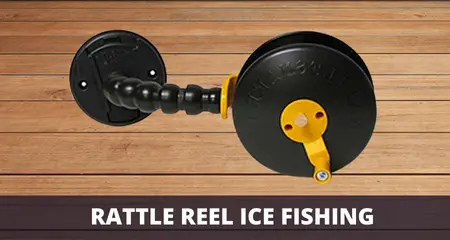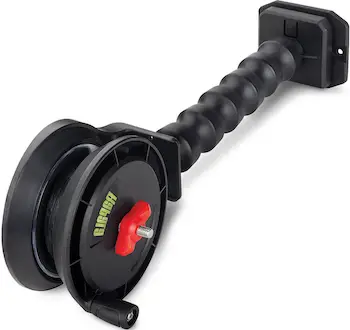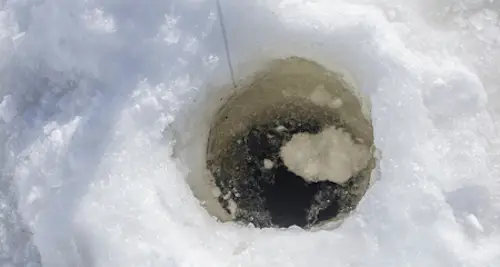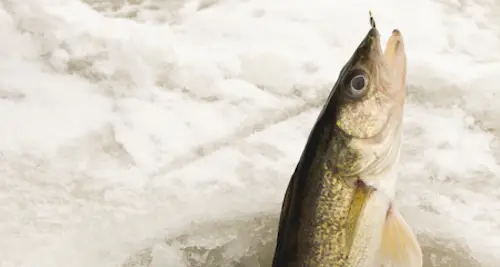Ice Fishing With RATTLE REELS (Everything You Need To Know)
UPDATED 18 MAY 2023
by Robert Ceran
Are you thinking about using rattle reels for your next ice fishing trip?
Rattle reels are a great tool for ice fishing with set lines inside a sleeper house, as they can catch fish for you even when you’re sleeping.
However, in order to use rattle reels effectively, you need to know how they work, and how to set them up correctly.

In this article we’ll walk you through the key things you need to know about rattle reels in order to catch more fish with ice fishing.
What is a rattle reel, and how does it work?
A rattle reel is a large spool that attaches to the side of an ice fishing wheelhouse, ice shelter, or large bucket.
It is designed to be placed above an ice hole, and works by lowering a baited hook and line down into the hole.

When a fish takes the bait, it swims off with the line and pulls it off the reel, thus causing the reel to make a rattling sound and alerting the angler to set the hook and land the fish.
The rattling sound is usually produced by plastic beads inside the spool housing.
Different brands of rattle reels make different kinds of rattling noises when line is pulled off their spool, ranging from a high pitched rattle to a deeper rattling sound.
It’s generally a good idea to check the sound of a rattle reel before you buy it, since you want to make sure that it’s loud enough to wake you up if you should fall asleep in your wheelhouse or shelter.
How do you use a rattle reel for ice fishing?
Rattle reels are predominantly used inside ice fishing sleeper houses (such as wheelhouses, trailers or RVs) that are parked on thick ice.
These houses have amenities to protect you from the elements and allow you to spend the night while fishing through the ice.
They also come with round floor openings that allow you to drill holes in the ice with your ice fishing auger right underneath each opening.
Rattle reels are designed to be attached to the shelter wall adjacent to each of the ice holes. For example, the Ultimate Rattle Reel comes with a metal arm that attaches to the wall, while the Rapala SmartHub Rattle Reel comes with a flexible plastic arm.
Once attached to the wall, the spool of the rattle reel can be positioned directly above the ice fishing hole, and is then used to lower a fishing line with a baited hook through the ice hole.

More recently, several brands have built rattle reels that can be attached to the side of a large bucket, or an ice hole sleeve.
Ice hole sleeves are essentially buckets with the bottom removed, and are inserted into a large ice fishing hole.
If you attach the rattle reel to the side of an ice fishing sleeve, that allows you to stow the reel underneath the surface of the ice, which leaves more space for the angler inside the shelter.
Finally, it can be a good idea to fish with an active jigging rod at one of your ice holes, since that helps to attract fish, which can then discover your baited rattle reel lines.
How to set up a rattle reel for ice fishing
Rattle reels are most often used with a slip bobber rig that suspends the baited hook 6 to 12 inches above the bottom.
However, you can also use a split shot rig without a bobber, and lower your baited hook until it rests directly on the bottom, and this works better for finicky walleye (more on that below).
The hook is most often baited with a small fish (such as a minnow, sucker or shiner). For trout or panfish you can also use mealworms, waxworms, or maggots.
Since you won’t be jigging the baited hook up and down, it’s best to use lively bait that moves enticingly in the water and triggers strikes from hungry fish.
The main line of the rattle reel is attached to a leader made of fluorocarbon, which is chosen as it has the least amount of visibility in the water, while being relatively resistant to the sharp teeth of species such as pike or muskie.
What line should you use on a rattle reel?
Traditionally, the main line used on rattle reels is Dacron, which is a type of braided line that is also often used on ice fishing tip ups.
However, the disadvantage of Dacron is that it tends to get tangled if you collect it in a pile, which is exactly what you need to do when pulling up a fish through an ice hole.
To avoid this problem, it’s better to use a coated braided line for ice fishing (such as the tip-up line made by Sufix), which comes with a special coating that prevents it from getting tangled.
The main line is attached to a fluorocarbon leader. You should choose the strength of both the main line and the leader to match the size of the fish you’re planning to catch.
Leader line length
The leader length depends on the clarity of the water, and on how line shy the fish are. In stained water, the leader can be as short as 3 feet, while you need to make it longer the clearer the water is.
If you’re fishing in crystal clear water (such as in lakes with zebra mussels), it’s possible to have a visibility of 20 feet or even more. In cases like that, you can even see your bait resting on the bottom underneath the ice hole
If you’re dealing with finicky walleye in water that’s as clear as that, you may need to extend the length of your leader all the way to your ice hole, so the fish don’t spot your fishing line.
The great thing about using fluoro is that it sinks in the water, which helps to keep your bait down in the strike zone.
What fish can you catch through the ice with a rattle reel?
Rattle reels are usually used to present a live bait within about a foot off the bottom, which is the ideal strike zone for walleye ice fishing.

And while walleyes are the species most often targeted with rattle reels, these reels also work well for catching other big fish, such as northern pike, burbot, and catfish.
If you want to target smaller species, such as trout or panfish, you’ll need to downsize your terminal tackle and line strength.
And if you use a slip bobber with your rattle reel setup, you can also opt to present your bait higher in the water, which can work well for suspended crappie or other fish suspended in the middle of the water column.
In general, it helps a lot to use sonar in order to find the right depth at which the fish are active underneath the ice, and then adjust your rattle reel setup to target that depth.
Rattle reel vs tip up (which is better?)
The general principle of a rattle reel is very similar to that of an ice fishing tip up, in that both devices are designed to suspend a baited line through an ice fishing hole, and both alert the angler when a fish takes the bait.
However, that’s where the similarities end. While a rattle reel alerts you with a loud rattling sound, a tip does the same thing with a brightly colored flag that tips up when a fish grabs the bait.
In addition, a rattle reel is primarily designed for use inside an ice fishing house or shelter, while a tip up is designed to be used on open ice.
So if you want to use set lines inside a shelter, a rattle reel is the better option for you, while tip ups are better on open ice.
Another advantage of using rattle reels inside a shelter is that they are loud enough to wake you up even if you fall asleep.
Tip ups, on the other hand, come with the advantage that they can be spaced out on open ice, and thus used to cover a large area with set lines, improving your odds of catching fish.
Advanced rattle reel tips for ice fishing
Now let’s take a look at some advanced tips and tricks for getting the most out of your rattle reel setup.
Set up your rattle reels on top of contour lines
Since fishing inside a wheelhouse or ice fishing house is a static fishing tactic, you should make sure to choose a good location to position your house, since this will determine how successful your rattle reel setups will be.
Experienced ice anglers look for humps and saddles in large flats, and then place their wheelhouse on the edge of one of these.
These structures attract both baitfish and predators such as walleye and northern pike, and finding one of these will greatly improve your chances of catching fish with your rattle reels.
Place your bait on the bottom for finicky walleye
While walleye bite aggressively early on in the ice fishing season, they tend to become more and more finicky as the hardwater season progresses towards mid and late ice (usually due to high fishing pressure).
Also, when the weather changes from high pressure to low pressure, this can have a strong effect on the feeding behavior of walleye, and fish that were actively biting a few days ago suddenly become very shy.
If you find yourself in one of these situations, you can improve your chances of catching finicky walleye by placing your baited hook on the bottom, instead of suspending it a few inches above the bottom.
The easiest way to do this is to use a weighted hook baited with a live minnow, and then monitor it with a flasher or an ice fishing sonar to track it while you lower it in the water column.
When the hook reaches the bottom, let the line go slack, and then reel the line in slowly until you have a straight line, but with the hook still lying on the bottom.
I’ve found that this bait presentation is much better for triggering bites from finicky walleye than a suspended live bait.
Final remarks
This concludes our article on rattle reel ice fishing. Hopefully our tips will help you to catch more fish on your next ice fishing trip.
Tight lines and see you on the ice!
